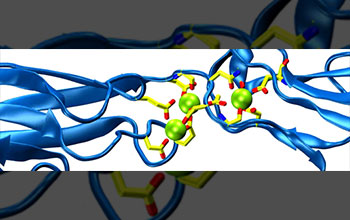Multimedia Gallery
Simulation of Stretched Protein
A close-up view of the linker region between cadherin-23, a molecule, is shown during a molecular dynamics simulation in which the protein is stretched from both ends. The simulations
mimic in vivo conditions in which tiplink (filiments in the hairs cells of the inner ear) cadherins are stretched during sound mechanotransduction at hair cells of the inner ear. Calcium ions (shown as green spheres) were found to be essential for the mechanical stability of the protein (shown in cartoon and sticks).
While little is known about the protein molecules involved in touch and auditory function, a team from Harvard University has resolved the atomic-level structure of a protein essential for sound perception. The structure was then simulated using TeraGrid supercomputers to determine how it functions in hearing and deafness. The molecular dynamics simulation pictured here was performed at the Texas Advanced Computing Center (TAAC) and the National Center for Supercomputing Applications (NCSA), which are both National Science Foundation-supported supercomputer centers. The computer time was obtained through a grant from the TeraGrid project.
To learn more about this research, see the TeraGrid Science Highlights 2010 story, "Decoding Deafness," on page 24 Here.
(Date of Image: March 2010)
Credit: Courtesy: Marcos Sotomayor, HHMI and Neurobiology Department, Harvard Medical
School. [M. Sotomayor, W.A. Weihofen, R. Gaudet, and D.P. Corey (2010) "Structural Determinants of Cadherin-23 Function in Hearing and Deafness" Neuron, 66:85-100.]
SORRY: THIS IMAGE IS NOT AVAILABLE IN HIGH RESOLUTION FORMAT
Special Restrictions: The owner of this image has stated that any use of this image must include the following reference, which also appears with credit: M. Sotomayor, W.A. Weihofen, R. Gaudet, and D.P. Corey (2010) "Structural Determinants of Cadherin-23 Function in Hearing and Deafness" Neuron, 66:85-100.
Images and other media in the National Science Foundation Multimedia Gallery are available for use in print and electronic material by NSF employees, members of the media, university staff, teachers and the general public. All media in the gallery are intended for personal, educational and nonprofit/non-commercial use only.
Images credited to the National Science Foundation, a federal agency, are in the public domain. The images were created by employees of the United States Government as part of their official duties or prepared by contractors as "works for hire" for NSF. You may freely use NSF-credited images and, at your discretion, credit NSF with a "Courtesy: National Science Foundation" notation.
Additional information about general usage can be found in Conditions.
Also Available:
Download the high-resolution JPG version of the image. (127 KB)
Use your mouse to right-click (Mac users may need to Ctrl-click) the link above and choose the option that will save the file or target to your computer.

